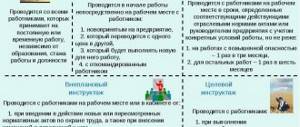| Can you really use this? |
The number of employees of an organization that is not a state or municipal institution and does not apply a tariff system of remuneration exceeds 50 people. The organization has created a labor protection service; there are positions of labor protection specialists filled by certain employees.
Consultation provided on November 19, 2014.
1. Is it possible to fill the position of a labor protection specialist by combining positions with an employee who has undergone appropriate training?
2. How to document this?
3. Does the employer have the right to establish qualification requirements for a labor protection specialist that differ from those specified in the ECTS?
4. Will an employee filling the position of a labor safety specialist by combining positions be held responsible for non-compliance with labor safety requirements by employees, as well as if an accident occurs?
If there are more than 50 employees, disputes arise
At the same time, on the issue of the possibility of combining the position of occupational safety specialist in an organization with more than 50 employees, there are two opposing positions.
So, according to Art. 217 of the Labor Code of the Russian Federation, in order to ensure compliance with labor protection requirements and monitor their implementation, each employer engaged in production activities, whose number of employees exceeds 50 people, creates a labor protection service or introduces the position of a labor protection specialist with appropriate training or experience in this area. Consequently, if the number of employees of an organization exceeds 50 people, the employer is obliged to create a labor protection service or introduce a staffing position for a labor protection specialist.
By virtue of part four of Art. 217 of the Labor Code of the Russian Federation, the structure of the labor protection service in the organization and the number of employees of the labor protection service are determined by the employer, taking into account the recommendations of the federal executive body that carries out the functions of legal regulation in the field of labor. One of these documents is the Recommendations for organizing the work of the labor protection service in an organization, approved by Resolution of the Ministry of Labor of the Russian Federation dated 02/08/2000 N 14 (hereinafter referred to as the Recommendations). Let us immediately make a reservation that the paragraphs of the Recommendations that will be discussed are based on the previously valid version of Art. 217 of the Labor Code of the Russian Federation and in connection with its changes have not yet been adjusted, however, from them one can discern a general approach to the situation under consideration.
As stated in paragraph 15 of the Recommendations, an occupational safety service is created or the position of an occupational safety specialist is introduced if the number of employees exceeds 100 people. Based on paragraph 16 of the Recommendations, if the number of employees is 100 or less, the head of the organization can assign occupational safety responsibilities to another specialist or other person (with his consent), who, along with his main job, will perform the duties of a labor protection specialist. From these standards it is clear that the ability to work as a part-time labor protection specialist is directly dependent on the number of employees of the organization for whom the specialist performs his functions. Thus, taking into account the currently valid version of Art. 217 of the Labor Code of the Russian Federation, we can conclude that the work of a labor protection specialist on a part-time basis is possible only if the number of employees of the organization is 50 people or less (see, for example, the decision of the Krasnoarmeysky District Court of Volgograd dated July 23, 2013 in case No. 12-200 /13).
At the same time, at present, labor legislation and other acts containing labor law standards do not establish restrictions on combining and other types of additional work for any positions and professions. Resolution of the USSR Council of Ministers dated December 4, 1981 N 1145 “On the procedure and conditions for combining professions (positions),” which contained such restrictions, was declared invalid on the territory of the Russian Federation by Decree of the Government of the Russian Federation dated March 10, 2009 N 216. This means that additional work during regular working hours can be assigned to an employee of any position or profession, be it the head of the organization, his deputy, the chief accountant, the head of a structural unit, another employee or worker.
Indeed, Art. 217 of the Labor Code of the Russian Federation establishes a mandatory requirement for the creation of an occupational safety service or the introduction of the position of an occupational safety specialist in an organization whose number of employees exceeds 50 people. However, there is no direct prohibition on filling such positions in a part-time or part-time manner, as indicated above. At the same time, Art. 217 of the Labor Code of the Russian Federation, Recommendations, Inter-industry standards for the number of labor protection service workers in organizations, approved by Resolution of the Ministry of Labor of Russia dated January 22, 2001 N 10, which regulate the optimal number of labor protection service workers, establish a requirement for the mandatory introduction of the position of labor protection specialist, but do not establish method of filling such a position (main, part-time, part-time).
Thus, the Ministry of Health and Social Development indicated that the occupational safety service is understood as a special unit, and a separate full-time occupational safety specialist, and the totality of all special units and individual employees engaged (including part-time and part-time) in organizing occupational safety issues for the employer ( in large organizations) (see clause 4.2 of the Information of the Ministry of Health and Social Development of the Russian Federation dated January 24, 2012 “Training and methodological recommendations for organizing training of federal civil servants in the field of professional protection (occupational safety) by personnel departments of federal government bodies”).
A small amount of judicial practice indirectly confirms the possibility of combining the position of a labor protection specialist in an organization with more than 50 employees (see, for example, the ruling of the Investigative Committee for civil cases of the Altai Regional Court dated September 1, 2010 in case No. 33-6722/2010, the decision of the Zarechensky City Court of the Penza region in the decision of 02/08/2013 in case No. 12-20/2013).
Therefore, we believe that filling the existing position of a labor protection specialist by combining positions or part-time work is possible.
Please note that this position is our expert opinion. To avoid claims from regulatory authorities, we recommend that you apply for official clarification to the Federal Service for Labor and Employment (Rostrud) by mail (109012, Moscow, Birzhevaya sq., 1) or by filling out a special application form on the official website of the department (https ://www.rostrud.ru/reception/55.shtml).
What to train part-time workers in labor safety?
Occupational safety training is the responsibility of all workers without exception. This is stated in Article 225 of the Labor Code of the Russian Federation.
In this case, the fact that the employee has already been trained in his main place of work does not matter. Even if the positions are the same.
A part-time employee is recognized as a newly hired employee. In accordance with the general procedure, an employment contract is signed with him and a corresponding order for employment is issued.
That is why he undergoes training like any other employee. Based on the results of the knowledge test, he is given a certificate.
The law does not establish specific rules for training part-time workers. Even if it is internal, the employer is required to issue a second certificate. Regular instruction will not work in this case.
This conclusion can be made based on the interpretation of articles of the Labor Code of the Russian Federation (60.1, 282).
What to train part-time workers?
Before starting independent work, they are given instructions on labor protection (initial and introductory). After this, an oral knowledge test is carried out; if the answers are satisfactory, a corresponding entry is made in the briefing log.
Also, part-time workers are given repeated briefings - once every six months. Under certain circumstances, the employer obliges them to undergo unscheduled and targeted training.
Within 1 month from the date of issuance of the order for employment, part-time workers are provided with training in labor protection and first aid (Article 225 of the Labor Code of the Russian Federation).
If an employee is involved in harmful and (or) dangerous working conditions, then in addition he undergoes an internship at the workplace and passes the appropriate exam.
In what cases is public control over labor protection required? Is a labor protection agreement a binding document? Find out here.
Internal (with one employer)
So, we have already determined that even internal part-time workers undergo repeated training in labor safety.
This is explained by the fact that a new employment agreement is concluded with the employee. An employment order is issued for him. Such an employee receives the status of a newly hired employee.
This is precisely why the need for repeated training is connected.
All required procedures for the new position are carried out with such an employee:
- briefings – in full;
- education;
- testing knowledge and issuing a certificate.
It is very important to comply with these legislative requirements, since otherwise the employer will be responsible for violating the law.
External
External part-time work has the following characteristics:
- the employee works part-time for an employer other than his main place of work;
- part-time work is carried out outside the normal working hours at the main place of work;
- Two labor agreements have been concluded with the employee.
So, the part-time employee is considered newly hired. He is given general instructions, and he also undergoes full labor safety training, certification, etc.
Even if the employee has already performed all these activities at his main place of work, this does not mean the cancellation of these part-time requirements. That is, when an employee works in the same position as under the first employment contract, he still undergoes training.
His absence of a certificate, as well as corresponding entries in the briefing log, will lead to the employer’s liability for failure to comply with the requirements of the Labor Code of the Russian Federation.
Documentation of combination
To properly document the combination, it is necessary to prepare two personnel documents:
— agreement of the parties to the employment contract on combination;
- order (instruction) of the employer on combination.
The employer's order (instruction) on combination formalizes the employer's decision to assign additional work to the employee. It is published with the written consent of the employee (which must be noted in this personnel document). The order (instruction) on combination defines:
— type of combination (combining positions; performing the duties of a temporarily absent employee without release from work specified in the employment contract);
— the period during which the employee will perform additional work;
— content of additional work;
- amount of additional work.
In addition, this order must reflect that the amount of additional payment for combination work is established by agreement of the parties to the employment contract.
In an agreement on the combination of parties to an employment contract, the issue of the amount of additional payment for the employee performing additional work assigned to him by the employer in another position is resolved.
The agreement of the parties to the employment contract on combination is valid either until the end of the period for which the combination was established, or until it is canceled by the employer or until the employee refuses to perform additional work in another position (part four of Article 60.2 of the Labor Code of the Russian Federation).
Employee position name
Within the meaning of Art. 15 and parts of the second article. 57 of the Labor Code of the Russian Federation, the name of the employee’s position is a mandatory condition of the employment contract, as well as one of the characteristics of his labor function.
At the same time, if a tariff system of remuneration is used when paying employees, and also if, in accordance with the Labor Code of the Russian Federation (other federal laws), the provision of compensation and benefits is associated with the performance of work in certain positions, professions, specialties or restrictions are established, then the name of these positions , professions or specialties and the qualification requirements for them must comply with the names and requirements specified in the Unified Tariff and Qualification Directory of Work and Professions of Workers and the Unified Qualification Directory of Positions of Managers, Specialists and Employees (Part Two of Article 57, Article 143 of the Labor Code of the Russian Federation).
In addition, in accordance with part five of Art. 144 of the Labor Code of the Russian Federation, the provisions of the unified tariff and qualification directory of works and professions of workers (UTKS), as well as the unified qualification directory of positions of managers, specialists and employees, are required to be taken into account by state and municipal institutions.
Since when performing work as a labor protection specialist, the legislation does not provide for the provision of any compensation, benefits and no restrictions are established, in the situation under consideration the employer is not a state or municipal institution and does not apply a tariff system of remuneration, he has the right to independently determine qualification requirements for this position (including being guided by the requirements for the position of “occupational safety specialist” contained in the relevant section of the Unified Qualification Directory of Positions for Managers, Specialists and Employees, approved by Order of the Ministry of Health and Social Development of the Russian Federation dated May 17, 2012 N 559n).
Thus, the employer, not being a state or municipal institution and not using a tariff system of remuneration, has the right to independently determine the requirements for the level of education and work experience necessary to occupy the position of occupational safety specialist, fixing them in a local act.
What should you do when combining responsibilities (professions)?
Internal combination of positions, unlike part-time work, does not require the signing of an employment contract.
An additional agreement is used to formalize the new provision. It contains information about the duties that the employee will subsequently perform. The employer does not issue an order to hire an employee, nor does he sign a new employment contract with him.
From this we can conclude that such an employee does not need to undergo occupational safety training again. If he already has a certificate and records of his completion of such instructions are included in the logbook for registering briefings, then there is no need for additional measures.
Why do we need three-stage labor protection control? What are the labor safety standards when working at a computer? Read here.
What is an external occupational safety audit? Find out here.










